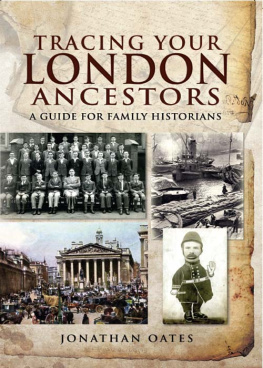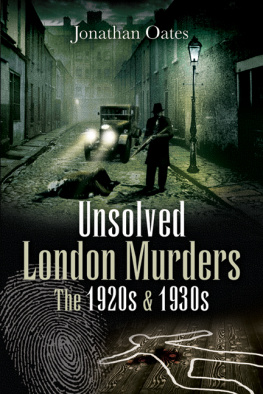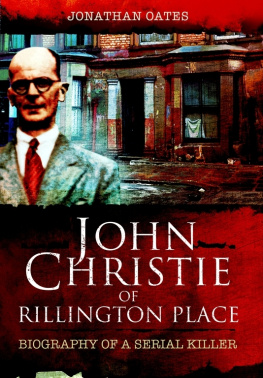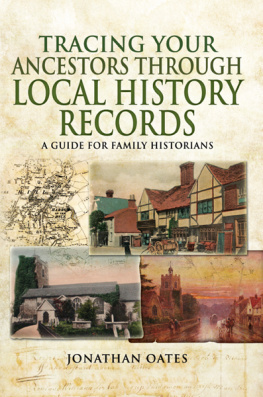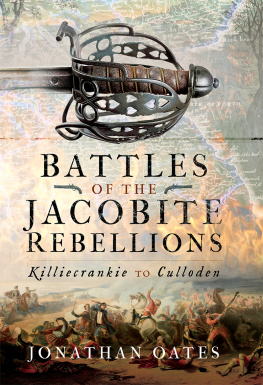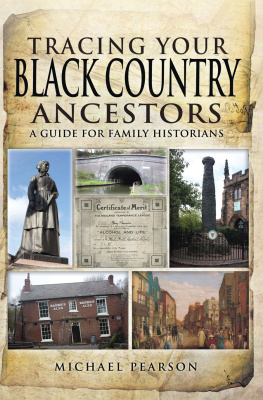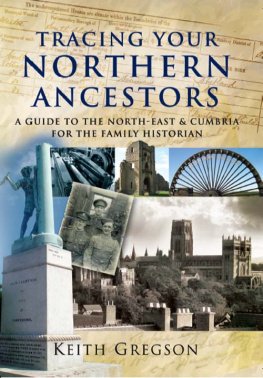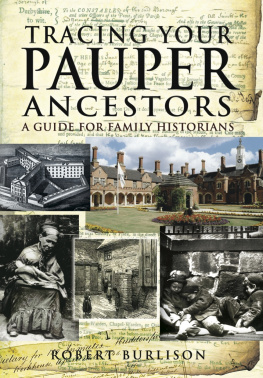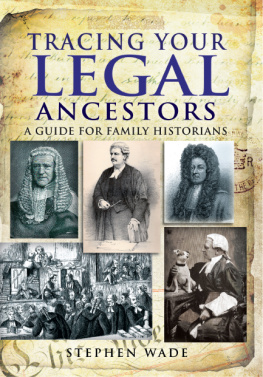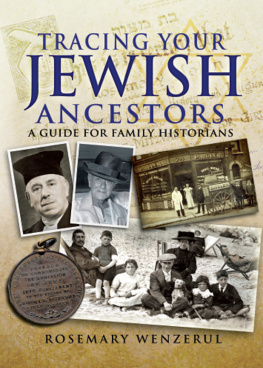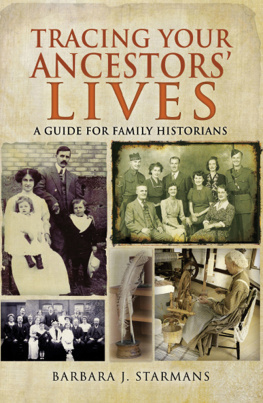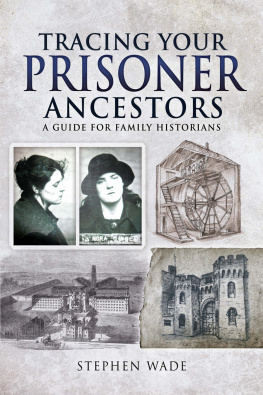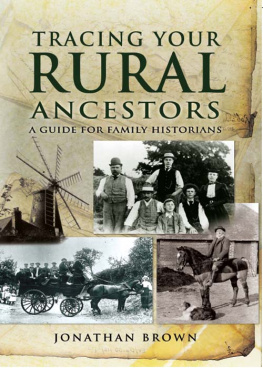
FAMILY HISTORY FROM PEN & SWORD
Tracing Your Yorkshire Ancestors
Rachel Bellerby
Tracing Your Royal Marine Ancestors
Richad Brooks and Matthew Little
Tracing Your Pauper Ancestors
Robert Burlison
Tracing Your Labour Movement Ancestors
Mark Crail
Tracing Your Army Ancestors
Simon Fowler
A Guide to Military History on the Internet
Simon Fowler
Tracing Your Northern Ancestors
Keith Gregson
Your Irish Ancestors
Ian Maxwell
Tracing Your Scottish Ancestors
Ian Maxwell
Tracing Your Air Force Ancestors
Phil Tomaselli
Tracing Your Secret Service Ancestors
Phil Tomaselli
Tracing Your Criminal Ancestors
Stephen Wade
Tracing Your Police Ancestors
Stephen Wade
Tracing Your Jewish Ancestors
Rosemary Wenzerul
Fishing and Fishermen
Martin Wilcox

First published in Great Britain in 2011 by
PEN & SWORD FAMILY HISTORY
an imprint of
Pen & Sword Books Ltd
Church Street
Barnsley
South Yorkshire
S70 2AS
Copyright Jonathan Oates 2011
ISBN 978 1 84884 130 7
Digital Edition ISBN 978 1 84468 687 2
The right of Jonathan Oates to be identified as Author of the Work has been asserted by him in accordance with the Copyright,
Designs and Patents Act 1988.
A CIP catalogue record for this book is available from the British Library.
All rights reserved. No part of this book may be reproduced or transmitted in any form or by any means, electronic or mechanical including photocopying, recording or by any information storage and retrieval system, without permission from the Publisher in writing.
Typeset in Palatino and Optima by
CHIC MEDIA LTD
Printed and bound in England by
CPI UK
Pen & Sword Books Ltd incorporates the imprints of
Pen & Sword Aviation, Pen & Sword Maritime, Pen & Sword Military, Wharncliffe Local History, Pen & Sword Select, Pen & Sword Military Classics, Leo Cooper, Remember When, Seaforth Publishing and Frontline Publishing
For a complete list of Pen & Sword titles please contact
PEN & SWORD BOOKS LTD
47 Church Street, Barnsley, South Yorkshire, S70 2AS, England
E-mail:
Website: www.pen-and-sword.co.uk
ACKNOWLEDGEMENTS
I have been greatly assisted by a number of kind friends who also happen to be knowledgeable upon subjects which I am not. This roll of honour includes Ruth Costello, John Coulter, John Gauss, and Professor Brian Kemp. Any errors, of course, are mine alone.
The book is dedicated to the memory of my late father-in-law, William Howard Bignell (19272009), who was born in Middlesex and whose ancestors lived in London since at least the early nineteenth century.

William Howard Bignell outside Woollaston Road, London, 1959.
Mrs Bignells collection
INTRODUCTION
M any people have lived, and do live, in London; perhaps about one fifth of the population. Some have been born there, some have moved there and some have died there. Some spent part of their lives here; some spent it all there. Some became famous and important figures in history, though most did not. All, however, made their imprint on the records created at the time, though some more than others. Their descendants may still live in London, but many may live elsewhere, either in other parts of the country or overseas. This book is a guide to finding out more about your London ancestors.
But this is easier said than done. When it is found that an ancestor has been born in or moved to London, it is not quite the same as discovering that they were from a small village. London and its myriad records, especially to those who do not now live there, can seem like a large and difficult mass to digest. It does not have to be so. This book will indicate the sources and where to find them, what they contain and how useful they are.
It is now certainly an opportune moment to research your London ancestors, given recent technological innovations. The author remembers, in 1997, thinking that the indexing of the 1881 census and its availability on microfiche was a major step forward, but now this seems comparatively trivial. Much of the basic work of making a skeletal family tree; using census returns, parish registers and birth, marriage and death certificates, can be done online, though often with fees to be paid. However, most records which can be used for research are not, and may never be, available electronically and it is these as well as the electronic sources which this book addresses.
Any readers starting to research their family history should certainly begin with both their living relatives and any documents held in the family, such as old certificates, newspaper cuttings, photographs, school reports and so forth. Many books about family history used to state that the Family Bible was a key place to start, but I have never knowingly met anyone who has one of these, so must assume these are mostly mythical. But starting with your older relatives and their family documents is the best, before you visit libraries and archives.
Two abbreviations which will be used throughout this book are LMA (London Metropolitan Archives) and TNA (The National Archives). Both of these places are ones which most readers will need to visit several times. Contact details for both are to be found in the Bibliography, but a brief introduction to both will now be given.
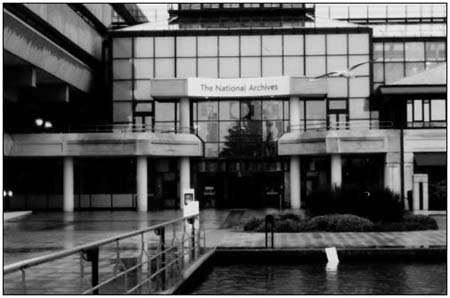
The National Archives, 2010. Authors collection
The LMA was created by a merger in 1979 between the London County Council Record Office and the Middlesex Record Office, both created between the World Wars. It was located at its present address in 1982 and was then known as the Greater London Record Office, renamed in 1997. In 200510, the archives of the Corporation of London Record Office and the Guildhall Manuscripts section were brought to this new site. It holds the archives of the Middlesex Quarter Sessions, the Metropolitan Board of Works, the London and Middlesex County Councils (LCC and MCC), the Greater London Council, parish and Nonconformist archives, school archives (strong for the schools in the former LCC, not for MCC), electoral registers and directories, some Jewish archives, some tax records and records of crime, prisons and trials. It also contains an excellent collection of photographs from the LCC, including many of schools.
TNA was formerly the Public Record Office, located at Chancery Lane in 1838, which slowly transferred to the present site at Kew in the 1990s and was given its new name in 2002. It holds the archives of central government. These include military archives (including First World War soldiers records), records of the Metropolitan Police, some taxation records, naturalization and some immigration records, a well-stocked library of directories and transcripts of documents and free digital access.
It should also be realized that this book covers what is now termed Greater London, but which was before 1965 Middlesex and London, as well as those parts of other counties adjoining London which were in Essex, Surrey and Kent.

